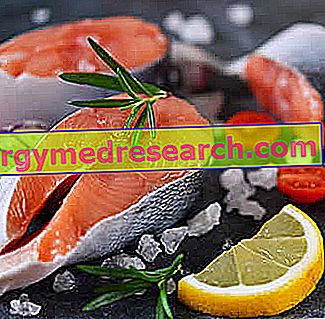What are Omega 3s?
Omega three are essential fatty acids, which the body is unable to synthesize; to this group belong alpha linolenic acid (ALA), eicosapentaenoic acid (EPA) and docosahexaenoic acid (DHA).

To remember:
- Omega-3s have many vital functions and any deficiency can be very harmful to health.
- To be precise, the only completely essential omega three is ALA, from which the body (via enzymes) is also able to extract EPA and DHA. On the other hand, this ability can be compromised by aging, certain drug therapies, eating disorders and other factors.
- Omega 3 is very susceptible to oxygen, free radicals, light and heat.
The best recipes for a diet rich in omega three are those that contain higher levels of ALA, DHA and EPA in the "finished dish".
This characteristic is the result of the union between the type of raw material and the processing technique.
Primary Sources of Omega Three
Before talking about recipes, it is important to understand which foods contain the essential omega-3s:
- Primary sources of alpha linolenic acid (ALA): are contained in fatty foods of vegetable origin. They abound in certain seeds and above all in their "living" part (germ or embryo). Secondly, they are also found in fleshy fruits, vegetables, etc.
- Primary sources of eicosapentaenoic and docosahexaenoic acid (EPA and DHA): they are mainly found in fishery products (fish, crustaceans and molluscs) and in algae (unicellular and multicellular).
NB . From the sources of essential fatty acids omega three, both animal and vegetable, it is possible to obtain oils that are particularly rich in nutrients.
On the other hand, choosing foods rich in ALA, EPA and DHA may not be enough.
Food Processing
The omega three are particularly sensitive to:
- Oxygen
- Free radicals
- Heat
- Light.
This requires following some precautions during processing, to prevent these nutrients from being compromised even before consumption:
- Store in an optimal manner: it concerns all the products and especially the oils extracted. Foods rich in omega 3 must be kept briefly and above all:
- In the cold (when possible, better below zero)
- In the dark
- Sealed tightly.
- Prevent contact oxidation: in addition to oxygen (present in the air) and free radicals (present in the food itself), the main source of oxidation (which mainly affects vitamins, fats and minerals) is represented by the contact with metals. It occurs mainly during cutting (knife, slicer blade, butcher's saw, etc.) and in storage (containers, etc.). Today there is a wide use of stainless steel which, among others, is considered the least "reducing". It is not certain that it is worth it but, from this point of view, it would be preferable to focus on innovative materials such as ceramics (for knives) and synthetic polymers (for containers).
- Cooking: to maintain the integrity of the omega 3 it is advisable (if possible) to eat them in a raw form. Cooking always negatively affects the integrity of these molecules and of all the thermolabile ones. Intense cooking almost immediately destroys omega three, but moderate cooking often requires longer times (with a similar effect). It is advisable not to exceed 100 ° C for a few minutes.
- Avoid dispersion: by preserving foods rich in omega three, they are diluted and lost. Even if the fats do not dissolve in water, the same happens during boiling (they are visible as superficial "holes").
Examples
The best omega three recipes can be divided into:
- Rich in ALA
- Rich in EPA and DHA.
Best Recipes with ALA
They are all those that contain certain seeds or their fat portion.
The seeds richest in omega 3 are: chia, kiwi, perilla, flax, blueberry, camellia, porcelain, olive, hemp, walnut, canola, soy and vine.
The seeds to be boiled for packaging the first courses are mainly chia, flax and soy.
From the same we get a flour very used for the basic mixtures:
- For those leavened (bread), it is also necessary to use a part of flour with gluten.
- It is not essential for pasta, but the gluten-free compound is less resistant to cooking.
Walnuts and hemp seeds can be eaten as a snack or in flour form.
Squeezing all the seeds rich in omega 3 you get an oil to use raw on the side dishes; on the other hand, not all of them are very palatable (especially of kiwi, blueberry and vine).
Best Recipes with EPA and DHA
They mainly concern fish, molluscs and crustaceans.
They are richer in omega 3: wild salmon, tuna belly, mackerel, bonito, sardines and other blue fish, fish liver, etc.
The carpaccio, the tartare, the various types of sushi and the marinated raw fillets preserve entirely the proportion of omega 3.
With regard to cooking, the systems are more suitable: at low temperature (under vacuum in water), vasocottura and steam cooking.
Oils derived from aquatic organisms (fish, fish liver, krill, algae, etc.) do not lend themselves to gastronomy and serve more than anything as food supplements.



